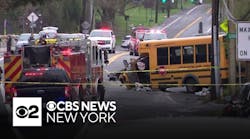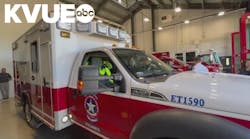May 26--Editor's Note: As Newburyport celebrates its 250th anniversary this year, The Daily News is publishing a series of articles that looks back on the city's history. Today we focus on two catastrophic fires that occurred in May. Both had major impacts on the development of the city.
The development of downtown Newburyport has been influenced by major fires, the Great Fire of 1811 and the Million Dollar Fire of 1934. Both leveled parts of the city and forced rebuilding that much influenced the look of the community.
It might be mentioned that in each case, associated events made these times of major hardship. In 1811, the community not only had to rebuild but it was facing an embargo that limited trade. Shortly thereafter, the War of 1812 brought international commerce to a standstill.
In 1934, the Great Depression had taken hold here as it had around the country. The destruction caused by the fire created major challenges, including homelessness, unemployment and growing fear of the future.
The Great Fire
"On Friday evening, May 31, 1811, at half past 9 o'clock in the evening, the citizens of the town were alarmed by the cry of Fire!"
So wrote John Gilman and Wittingham Gilman in late 1811.
Historians say it started on "an unimproved stable" in Mechanic Row (now Inn Street), and it swept up State Street and into Middle Street "as far as Fair Street," Liberty Street and parts of Water Street. The area encompasses most of the city's downtown.
The authors say that nearly 250 buildings were burned, most of which were stores and dwelling houses. It was estimated that 16.5 developed acres were destroyed, "containing a much larger proportion of wealth of the town than any other part."
They wrote, "Nearly all the dry goods stores were lost including: (all) four printing offices including the Newburyport Herald office; the custom house, the surveyor's office; the Post Office, two insurance offices; the Baptist meetinghouse; four attorneys' offices; four book stores and also the town library."
The authors wrote, "The streets were thronged with those whose dwellings were consumed, the incessant crash of falling buildings, the roaring of chimneys like distant thunder, the flames ascending in curling volumes from a vast extant of ruins, the air filled with a shower of fire ... the looing of the cows and the confused noise of exertion and distress, united to impress the mind with the most awful sensations."
The blaze was still raging at 2 a.m., but by 6 a.m., "the fire had in great degree spent its fury."
Historians say more than 90 families were driven from their habitations ... and "many were deprived of the means of supporting themselves with the necessities of life."
The financial loss "cannot fall short of $1 million," and business was at a standstill for days.
Firefighters rushed to Newburyport from nearby communities; residents from all over the region contributed food, clothing and furniture to those who had lost everything.
The impact of the fire was felt as far away as the state capital in Boston, and legislators quickly passed measures that mandated that the city be rebuilt with brick and stone.
Reconstruction did get underway, and much of the downtown rebuilt with red brick buildings with tall firewalls separating them.
Historians say that this is "why Newburyport is Newburyport" -- the distinctive brick downtown is a direct outgrowth of the rebuilding that took place after the Great Fire of 1811.
Perhaps because Newburyporters were appalled by destructive fires, residents dealt harshly with an arsonist less than a decade later.
In August 1820, a stable on Temple Street caught fire, and led to the loss of several other stables, a double tenement and three single-family homes.
Several horses were lost, and many were homeless. No deaths were reported.
Authorities called it arson and arrested a 16-year-old Ship Street boy named Stephen M. Clark. He had been in trouble with the law, and often was seen in the company of young women known as "nightwalkers."
As local historian Joe Callahan recently related in these pages, Clark was tried, found guilty and on May 10, 1821, he was hung at Execution Hill on Winter Island in Salem.
At the time, Clark was the youngest person ever executed for a crime in the United States.
The execution of a teen for a crime that did not result in the loss of human life caused a debate throughout the country about capital punishment. At the least, it resulted in changes in the penalty for arson from death to some length of imprisonment, depending on the circumstances.
Million Dollar Fire
The fire of 1934 came during the Depression, and may have helped change the direction of the city's economy.
Local historian Jean Foley Doyle wrote in her two-part history of the city, "It had a major effect on the economy in Newburyport. It wiped out what remained of the shoe industry, left people homeless and added to the fear of destitution that was sweeping the country."
She writes that the fire broke out at the Dodge Brothers Shoe Company near the corner of Merrimac Street and Bridge Road. The fire jumped to the Gillis building on Bridge Road, then across Merrimac Street to the Kerkian buiding, and proceeded down both sides of Merrimac Street, driven by a strong wind from the southwest.
"The fire leveled all buildings, with one exception, from Winter Street to Titcomb Street," she wrote.
Foley wrote that "By the time the last ember was extinguished, 15 families were homeless, and 500 people were unemployed. Damage was estimated at $1 million."
That was an enormous sum of money in Depression-afflicted Newburyport; thus the fire earned the name the "Million Dollar Fire."
Veteran historian John Lagoulis, who then lived at 14 Unicorn St., wrote in The Daily News several years ago, "During that devastating fire, all the families living in the Merrimac Street area from the bridge to Market Square, including the downtown areas, were awake throughout the night into daylight hours. Every family in the Market Square area was fighting the fire with their bare hands, trying to save their homes and families. Support came from all surrounding cities and towns and even from New Hampshire. It was a confusing and terrible night, a night of destruction. At daybreak, everything was burnt and black and dirty and smoldering with soot and the smoke was still rising. People stayed in their homes, exhausted. The streets were empty and dark."
Municipal reports stated that 22 pieces of firefighting equipment were used, with 268 regular firemen on duty from at least a dozen neighboring communities.
In a memoir supplied by local historian Ghlee Woodworth, onetime fire Chief John F. Cutter wrote, "During the fire, a welcome Salvation Army traveling sandwich, doughnut and coffee truck arrived, and contents of same was appreciated by the members who were detailed on fire duty."
Arson was suspected but no one ever was convicted.
That part of the city has been rebuilt, of course, and is part of the immediate future.
Much of the property on Merrimac Street between Market and Titcomb streets is owned by New England Development, and City Hall officials say a hotel and parking garage may be developed there.
As bad as it was, then-Mayor Gayden W. Morrill sounded appreciative that things weren't worse when he wrote a letter to The Daily News several days after the blaze.
"On behalf of the people of Newburyhport, I wish to thank everyone who assisted in checking the conflagration which destroyed so much of our property ... had it not been for the valuable aid which we received, results would have been more disastrous to our city."
Copyright 2014 - The Daily News of Newburyport, Mass.





